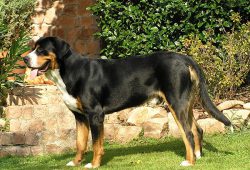The Greater Swiss Mountain Dog (German: Grosser Schweizer Sennenhund or French: Grand Bouvier Suisse) is a dog breed which was developed in the [wiki title=”Swiss_Alps” base=”EN”]Swiss Alps[/wiki]. The name Sennenhund refers to people called Senn or Senner, dairymen and herders in the Swiss Alps. Greater Swiss Mountain Dogs are almost certainly the result of indigenous dogs mating with large mastiff types brought to Switzerland by foreign settlers. At one time, the breed was believed to have been among the most popular in Switzerland. It was assumed to have almost died out by the late 19th century, since its work was being done by other breeds or machines, but was rediscovered in the early 1900s.
Appearance
The Greater Swiss Mountain Dog is a draft and drover breed; it is a large, heavy-boned dog with incredible physical strength. Despite being heavy-boned and well-muscled, the dog is agile enough to perform the all-purpose farm duties of the mountainous regions of its origin.
Coat
There is black on top of the dog’s back, ears, tail and the majority of the legs. There should be rust on the cheeks, a thumb print above the eyes, and also rust should appear on the legs between the white and black. There should be white on the muzzle, the feet, the tip of the tail, on the chest, and up from the muzzle to pass between the eyes. Symmetrical markings are preferred by breeders.
Size
Males range between 25.5 to 28.5 in (65 to 72 cm) at the shoulder and females range between 23.5 to 27 in (60 to 69 cm) at the shoulder. There is no standard for weight in the Greater Swiss Mountain Dog; males tend to range between 120 to 155 lb (54 to 70 kg) and females range between 100 to 115 lb (45 to 52 kg). Body length to height is approximately a 10 to 9 proportion; they are slightly longer than tall.
Temperament
The Greater Swiss Mountain Dog is happy with an enthusiastic nature and strong affinity to people and children. This breed is sociable, active, calm and dignified. They do need plenty of room to exercise. They will not be happy confined to kennel life; they want to enjoy their family. They crave attention and physical contact. Greater Swiss Mountain Dogs are bold, faithful and willing workers and are eager to please. The Greater Swiss Mountain Dog is confident in nature; the breed is gentle with children. They can be stubborn and determined. The Greater Swiss Mountain Dog is an intelligent breed and is a quick learner. They can be difficult to housebreak, taking up to 6 months or more; and tend to try to eat just about anything, edible or not.
The activity level in the Greater Swiss Mountain Dog is variable. They are capable of being athletic, but usually that activity is in bursts; they are active for short periods of time followed by napping. They want to be with their owners and to participate; their activity level most often matches the activity level of the family. As a working dog, they like having a job to do and enjoy participating in hiking, carting, obedience trials, herding, weight pulling and backpacking with their owners.
Health
For the most part, this breed is relatively healthy for their size; Greater Swiss Mountain Dogs have far fewer problems than more populous breeds in the similar size range.
Lifespan
Heavier dogs such as the Greater Swiss Mountain Dogs tend to have shorter lifespans than medium- and small-sized dogs; longevity is inversely related to breed size. Two websites list the life expectancy for Greater Swiss Mountain Dogs at 10 to 11 years; another lists it as 8–10 years. A survey by the US breed club shows a median lifespan of 6.75 years. Dog lifespans may vary in different countries, even in the same breed.
Greater Swiss Mountain Dog. (2017, August 3). In Wikipedia, The Free Encyclopedia. Retrieved from https://en.wikipedia.org/w/index.php?title=Greater_Swiss_Mountain_Dog&oldid=793708688


